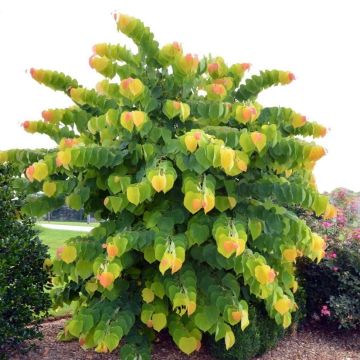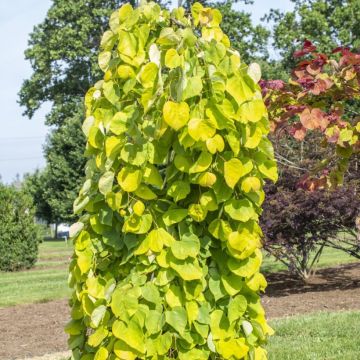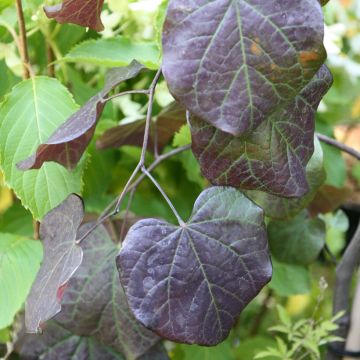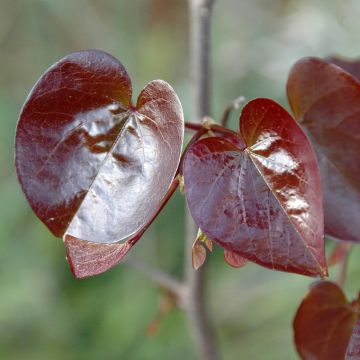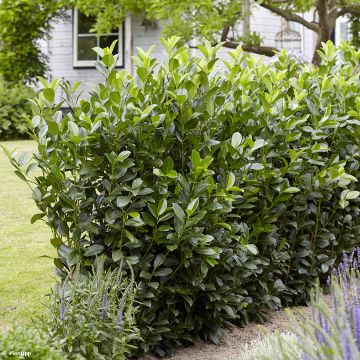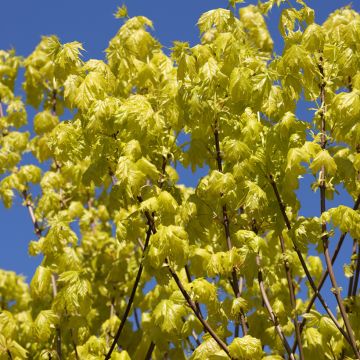

Cercis canadensis - Eastern Redbud


Cercis canadensis - Eastern Redbud


Cercis canadensis - Eastern Redbud


Cercis canadensis - Eastern Redbud
Cercis canadensis - Eastern Redbud
Cercis canadensis
Eastern Redbud, Judas Tree
Why not try an alternative variety in stock?
View all →This plant carries a 24 months recovery warranty
More information
We guarantee the quality of our plants for a full growing cycle, and will replace at our expense any plant that fails to recover under normal climatic and planting conditions.
Does this plant fit my garden?
Set up your Plantfit profile →
Description
Cercis canadensis, known as Eastern Redbud or Canadian Redbud, is a deciduous small tree that is very hardy and easy to grow in many gardens. It is ornamental with its pink flowering that is visible on the bare wood from early spring and its richly coloured autumn foliage. In winter, the fallen leaves reveal the twisted branches of this small tree with almost black bark.
Cercis canadensis belongs to the Fabaceae family (formerly known as Papilionaceae or legumes). It is a species highly resistant to frost, native to the eastern and central United States. The growth of this small tree is quite slow, and its average adult size is about 9m in height and 6m in spread, depending on the growing conditions. When regularly pruned, the Eastern Redbud forms a large bush with multiple trunks. It has a spreading habit, slightly taller than wide, with a short trunk and twisted branches. The flowers appear before the leaves, in March or April depending on the climate, directly on the trunk and branches. They resemble pea flowers in a purplish pink colour and are clustered in small visible clusters. This flowering is pollinated by insects. The fruits are flattened and hairy pods containing brown seeds. The leaves of Cercis canadensis are arranged alternately on the branches, have a heart-shaped form, and can measure up to 10cm in length. They emerge in spring with a bronze hue, then turn dark green in summer. In autumn, they display shades ranging from golden yellow to purple red, offering a dazzling spectacle before falling. The branches of old specimens branch out towards the ground. The bark of young trees is smooth and thin, ranging in colour from reddish-brown to grey-brown. It has visible lenticels (small openings for gas exchange) irregularly distributed over the entire surface of the bark. With age, the bark thickens and slightly cracks, forming shallow ridges and furrows. The colour of this bark changes from reddish-brown to dark grey-brown. The lenticels remain present but become less visible as the bark thickens.
This Eastern Redbud or Canadian Judas Tree tolerates a wide range of climates and adapts to deep and not-too-dry soils in summer. This ornamental small tree can be planted individually, in a large hedge, or in a grove. In neutral or alkaline, well-draining soil, you can associate it, for example, with a Field Maple, a Winged Euonymus, and a 'Raywood' Ash to create a vibrant grove from September to November.
Report an error about the product description
Cercis canadensis - Eastern Redbud in pictures


Plant habit
Flowering
Foliage
Botanical data
Cercis
canadensis
Fabaceae
Eastern Redbud, Judas Tree
North America
Other Cercis
View all →Planting and care
Cercis canadensis enjoys the sun and tolerates partial shade in very hot and sunny regions. It is not very demanding on the soil type, as long as it is quite rich and retains some moisture in the summer. This species is less drought-tolerant than its Mediterranean cousin Cercis siliquastrum (Judas tree). In poor soil, enrich the planting soil with good compost or potting soil. Water it regularly during the first seasons in any drought, as it dislikes dryness. It can tolerate any type of soil, but prefers neutral or slightly acidic soils. It is perfectly hardy, but young shoots may suffer from severe frost in early spring. Protection with winter fleece may be useful in the first few years in case of a severe cold spell in March. Prune if necessary after flowering.
Planting period
Intended location
Care
This item has not been reviewed yet - be the first to leave a review about it.
Similar products
Haven't found what you were looking for?
Hardiness is the lowest winter temperature a plant can endure without suffering serious damage or even dying. However, hardiness is affected by location (a sheltered area, such as a patio), protection (winter cover) and soil type (hardiness is improved by well-drained soil).

Photo Sharing Terms & Conditions
In order to encourage gardeners to interact and share their experiences, Promesse de fleurs offers various media enabling content to be uploaded onto its Site - in particular via the ‘Photo sharing’ module.
The User agrees to refrain from:
- Posting any content that is illegal, prejudicial, insulting, racist, inciteful to hatred, revisionist, contrary to public decency, that infringes on privacy or on the privacy rights of third parties, in particular the publicity rights of persons and goods, intellectual property rights, or the right to privacy.
- Submitting content on behalf of a third party;
- Impersonate the identity of a third party and/or publish any personal information about a third party;
In general, the User undertakes to refrain from any unethical behaviour.
All Content (in particular text, comments, files, images, photos, videos, creative works, etc.), which may be subject to property or intellectual property rights, image or other private rights, shall remain the property of the User, subject to the limited rights granted by the terms of the licence granted by Promesse de fleurs as stated below. Users are at liberty to publish or not to publish such Content on the Site, notably via the ‘Photo Sharing’ facility, and accept that this Content shall be made public and freely accessible, notably on the Internet.
Users further acknowledge, undertake to have ,and guarantee that they hold all necessary rights and permissions to publish such material on the Site, in particular with regard to the legislation in force pertaining to any privacy, property, intellectual property, image, or contractual rights, or rights of any other nature. By publishing such Content on the Site, Users acknowledge accepting full liability as publishers of the Content within the meaning of the law, and grant Promesse de fleurs, free of charge, an inclusive, worldwide licence for the said Content for the entire duration of its publication, including all reproduction, representation, up/downloading, displaying, performing, transmission, and storage rights.
Users also grant permission for their name to be linked to the Content and accept that this link may not always be made available.
By engaging in posting material, Users consent to their Content becoming automatically accessible on the Internet, in particular on other sites and/or blogs and/or web pages of the Promesse de fleurs site, including in particular social pages and the Promesse de fleurs catalogue.
Users may secure the removal of entrusted content free of charge by issuing a simple request via our contact form.
The flowering period indicated on our website applies to countries and regions located in USDA zone 8 (France, the United Kingdom, Ireland, the Netherlands, etc.)
It will vary according to where you live:
- In zones 9 to 10 (Italy, Spain, Greece, etc.), flowering will occur about 2 to 4 weeks earlier.
- In zones 6 to 7 (Germany, Poland, Slovenia, and lower mountainous regions), flowering will be delayed by 2 to 3 weeks.
- In zone 5 (Central Europe, Scandinavia), blooming will be delayed by 3 to 5 weeks.
In temperate climates, pruning of spring-flowering shrubs (forsythia, spireas, etc.) should be done just after flowering.
Pruning of summer-flowering shrubs (Indian Lilac, Perovskia, etc.) can be done in winter or spring.
In cold regions as well as with frost-sensitive plants, avoid pruning too early when severe frosts may still occur.
The planting period indicated on our website applies to countries and regions located in USDA zone 8 (France, United Kingdom, Ireland, Netherlands).
It will vary according to where you live:
- In Mediterranean zones (Marseille, Madrid, Milan, etc.), autumn and winter are the best planting periods.
- In continental zones (Strasbourg, Munich, Vienna, etc.), delay planting by 2 to 3 weeks in spring and bring it forward by 2 to 4 weeks in autumn.
- In mountainous regions (the Alps, Pyrenees, Carpathians, etc.), it is best to plant in late spring (May-June) or late summer (August-September).
The harvesting period indicated on our website applies to countries and regions in USDA zone 8 (France, England, Ireland, the Netherlands).
In colder areas (Scandinavia, Poland, Austria...) fruit and vegetable harvests are likely to be delayed by 3-4 weeks.
In warmer areas (Italy, Spain, Greece, etc.), harvesting will probably take place earlier, depending on weather conditions.
The sowing periods indicated on our website apply to countries and regions within USDA Zone 8 (France, UK, Ireland, Netherlands).
In colder areas (Scandinavia, Poland, Austria...), delay any outdoor sowing by 3-4 weeks, or sow under glass.
In warmer climes (Italy, Spain, Greece, etc.), bring outdoor sowing forward by a few weeks.




































